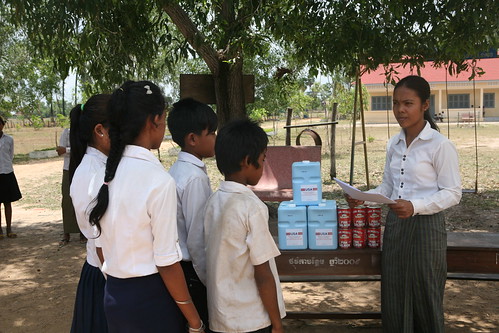USDA’s Foreign Agricultural Service
(FAS) partners with a variety of non-profit groups, cooperatives and
international organizations to promote food security in developing
countries around the world. The following guest blog highlights the
successful partnership between FAS and International Relief &
Development in Cambodia.
A two-hour boat ride on a warm breezy day
takes us to Prey Kri Choeung Primary School, near the base of a rocky
mountain in Prey Kri Tbong village in Cambodia’s Kampong Chhnang
Province. There, Rath Khemra, a local Food for Education field monitor
with the non-profit International Relief & Development
(IRD), stops by to attend a local school support committee meeting. The
schoolmaster, Hung Phalla, tells the group how delighted she is that USDA’s McGovern-Dole Food for Education
program is contributing to significant improvements in her school. She
notes the increased school attendance and enrollment rates of
school-aged children and their teachers. “All of this has made for much
better education in my school,” she says, adding that “the physical
appearance of the students is healthier as well.”
IRD implements the USDA Food for Education
program in 125 schools in Kampong Chhnang Province by providing healthy
on-site meals and take-home rations. The meals consist of corn-soy
blend and vitamin A- fortified soybean oil, which are donated under
USDA’s McGovern-Dole International Food for Education and Child
Nutrition Program, as well as salt, spices or palm sugar, and raisins or
other fruit, which are procured locally. The dish is similar to the
rice-based ba bor, a traditional Cambodian breakfast food.
Take-home rations include USDA-donated beans and canned salmon. IRD also
works with community volunteers to provide safe transportation to
school for girls from remote and flood-prone villages in the province.

A
teacher at Damnak Key School in Cambodia distributes take-home rations
to students with good attendance records. (Photo credit: International
Relief & Development)
Prey Kri Choeung Primary School was
selected for assistance in 2009 because its needs were so dire: student
and teacher absenteeism was high, children were hungry at school, and
enrollment was low. IRD coordinated with the education authorities at
the provincial, district, and school levels to provide the daily meals
and train volunteer cooks. The school support committee donated a
kitchen shelter, cooking pans, a stove, and ingredients such as sugar
and salt. IRD trained the teachers and school masters to keep records of
student and teacher attendance. After building water and sanitation
infrastructure in schools, IRD used traditional puppet shows to educate
students and teachers about basic nutrition, hygiene, and sanitation.
Following the shows, IRD also distributed hygiene kits consisting of
soap, toothpastes, toothbrushes, shampoos and other basic hygiene
supplies.
Non Prounh, a village leader and chief of
the school support committee, says, “Most parents now want their
children enrolled by age six.” He said that while the food is a strong
incentive, once in school, “the children are more attentive in class
because they are not hungry.”
IRD, together with the government
education authority, faith-based organizations, village chiefs, and
commune councils, conducted an enrollment campaign to alert parents of
the value of education and to encourage them to enroll their children in
school. Prior to the campaign, IRD trained the school support
committee, community activists, and teachers how to use communication
materials, such as banners and posters, to solicit community
contributions and promote parent involvement.
“Before, many parents had stopped sending
their children to school once they completed primary education. But
after the campaigns, many have changed their attitudes and now support
their children to continue to secondary school,” says Pov Rein, a parent
representative.
McGovern-Dole Food for Education Project in Cambodia, Key Successes 2009-2011:
- The number of students completing primary education increased 89 percent, from 1,235 to 2,328.
- Enrollment of school-aged children increased by 70 percent, from 1,794 to 3,044.
- School attendance among boys increased from 75 percent to 84 percent, and among girls, from 80 percent to 88 percent.
- Before the start of the project, only 54 percent of teachers had perfect attendance. By year two, that percentage increased to 96.
- 24,000 students received education on basic nutrition, hygiene, and sanitation each year.
- Up to 50,000 parents and community members participated in awareness campaigns on the advantages of education.
By Son Siveth, Project Manager, International Relief & Development

1 comment:
Khmer rouge gaaaaaaaaaaaaaaaal!
Post a Comment